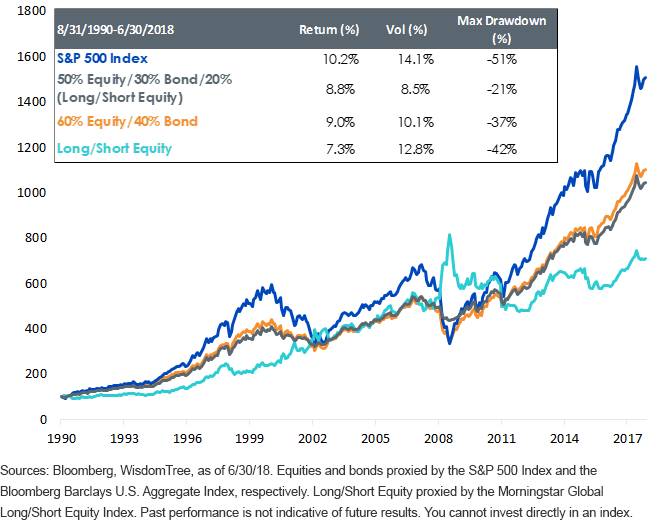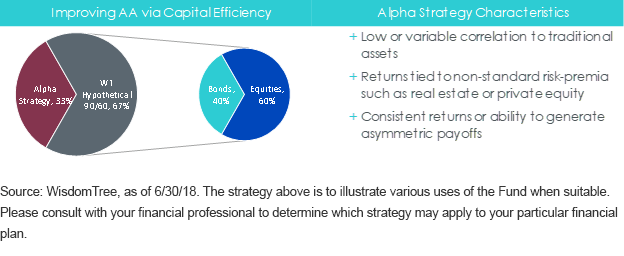Introducing the WisdomTree 90/60 U.S. Balanced Fund (NTSX)


For many investors, a balanced portfolio (60% equities,1 40% bonds2) serves as the bedrock (and benchmark) for their asset allocation (AA) decisions. From this core, they will often seek to select securities with characteristics that can provide diversification, return enhancement or manage volatility.
Thanks in large part to investment community feedback we received on Twitter, WisdomTree saw the need to create a more capital-efficient vehicle for providing exposure to the traditional 60/40 AA vehicles.
The general concept is that if an investor could potentially free up capital for diversifying strategies, that investor could complement a 60/40 allocation with alternative strategies that might assist in lowering volatility. While risk parity strategies employ some similar tactics, and there are some actively managed bond managers who then try to add equity index returns on top of the bonds, until now, there was no models-based implementation of this more capital-efficient 60/40 concept.
Balancing Trade-offs in 60/40
Historically, if investors wanted to make an allocation to commodities or alternatives, they would need to fund those positions by selling from their core holdings. Allocations to diversifying assets such as these have primarily sought to reduce volatility or limit drawdowns. While these assets could potentially add value, if they underperformed stocks or bonds, the returns of the portfolio could lag.
Relatively strong equity performance post-2008 typically has meant that any approach that reduced exposure to stocks has resulted in a portfolio with suboptimal returns. However, we also know that even a 60/40 portfolio can be prone to periods of significant drawdowns.
By combining a hypothetical portfolio of uncorrelated assets, the total volatility and drawdown profile of a 50% equity/30% bond/20% long/short equity portfolio offers meaningful enhancement compared with the alternatives. One challenge is in maintaining exposure to the core of the portfolio while adding these desirable portfolio traits.
Risk, Returns and Drawdowns

The Efficiency of 90/60
The WisdomTree 90/60 U.S. Balanced Fund (NTSX) is created by investing 90% of Fund assets in equities and 10% in short-term fixed income. The 60% bond exposure is achieved by overlaying Treasury futures contracts to achieve the net 90/60 target. Through this higher-efficiency portfolio, investors can devote a smaller percentage of their assets (66.6%) to core holdings while still pursuing their desired exposure.
In addition to helping potentially boost capital efficiency, we also believe that 90/60 provides investors with the ability to enhance returns with non-core assets such as long/short equities, risk parity, commodity trading advisors or true alternatives. In other words, by deploying an overlay strategy to boost capital efficiency, a 90/60 strategy has the potential to enhance total returns while also helping to dampen volatility via alternatives.
Evolving Traditional 60/40 with Alternatives

For definitions of terms in the chart, please visit our glossary.
Tax Efficiency of Structure
Structuring NTSX using equities and bond futures instead of underlying bonds with an equity swap also aims to help improve the tax efficiency of the portfolio, in our view. We will review the tax efficiency of the strategy in a later blog post.
INVESTMENT STRATEGY OF NTSX:
- Invest 90% of its net assets in the 500 largest U.S. equities by market capitalization.
- Invest 10% in short-term fixed income that collateralizes a 60% notional exposure to U.S. Treasury futures (2-, 5-, 10-, 30-year ladder).
- Should the Fund deviate from the targeted 90% equity and 60% U.S. Treasury allocations by 5%, the Fund will be rebalanced back to target allocations.
1As proxied by the S&P 500 Index.
2As proxied by the Bloomberg Barclays U.S. Aggregate Bond Index.
Important Risks Related to this Article
There are risks associated with investing, including possible loss of principal. While the Fund is actively managed, the Fund’s investment process is expected to be heavily dependent on quantitative models, and the models may not perform as intended. Equity securities, such as common stocks, are subject to market, economic and business risks that may cause their prices to fluctuate. The Fund invests in derivatives to gain exposure to U.S. Treasuries. The return on a derivative instrument may not correlate with the return of its underlying reference asset. The Fund’s use of derivatives will give rise to leverage, and derivatives can be volatile and may be less liquid than other securities. As a result, the value of an investment in the Fund may change quickly and without warning, and you may lose money. Interest rate risk is the risk that fixed income securities, and financial instruments related to fixed income securities, will decline in value because of an increase in interest rates and changes to other factors, such as perception of an issuer’s creditworthiness. Please read the Fund’s prospectus for specific details regarding the Fund’s risk profile.
Diversification does not eliminate the risk of experiencing investment losses. Using an asset allocation strategy does not assure a profit or protect against loss. Investors should consider their investment time frame, risk tolerance level and investment goals.
Neither WisdomTree Investments, Inc., nor its affiliates, nor Foreside Fund Services, LLC, or its affiliates provide tax advice. All references to tax matters or information provided in this material are for illustrative purposes only and should not be considered tax advice and cannot be used for the purpose of avoiding tax penalties. Investors seeking tax advice should consult an independent tax advisor.

Jeremy Schwartz has served as our Global Chief Investment Officer since November 2021 and leads WisdomTree’s investment strategy team in the construction of WisdomTree’s equity Indexes, quantitative active strategies and multi-asset Model Portfolios. Jeremy joined WisdomTree in May 2005 as a Senior Analyst, adding Deputy Director of Research to his responsibilities in February 2007. He served as Director of Research from October 2008 to October 2018 and as Global Head of Research from November 2018 to November 2021. Before joining WisdomTree, he was a head research assistant for Professor Jeremy Siegel and, in 2022, became his co-author on the sixth edition of the book Stocks for the Long Run. Jeremy is also co-author of the Financial Analysts Journal paper “What Happened to the Original Stocks in the S&P 500?” He received his B.S. in economics from The Wharton School of the University of Pennsylvania and hosts the Wharton Business Radio program Behind the Markets on SiriusXM 132. Jeremy is a member of the CFA Society of Philadelphia.

